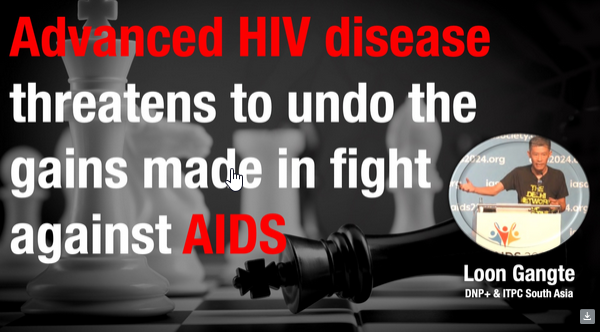o one needs to die of AIDS because, thanks to science, lifesaving antiretroviral therapy and viral suppression can gift all people living with HIV a healthy and fulfilling life. But, unfortunately, many a slip between the cup and the lip. "Even one AIDS death is a death too many. Despite having the tools and scientific know-how to avert AIDS deaths, 630,000 people died of AIDS in 2022. Governments, donors, pharmaceutical and medical device manufacturing companies, HIV and health advocates and activists, and all other stakeholders could have done better if we were to avert AIDS-related deaths," said firebrand health and human rights activist Loon Gangte who leads Delhi Network of People living with HIV (DNP Plus) and International Treatment Preparedness Coalition (ITPC) in South Asian region.
Looming threat of advanced HIV disease
According to the World Health Organization (WHO), people with advanced HIV disease are at a very high risk of opportunistic infections and deaths. About one fifth of people living with HIV admitted to hospital do not survive their hospital admission, and of those who survive, nearly a third die or are readmitted to hospital within a year.
People with advanced HIV disease are dying. It is time to hold governments to account, said Loon. He was speaking at a pre-conference of 25th International AIDS Conference (AIDS 2024) in Munich, Germany.
WHO defines advanced HIV disease as CD4 cell count less than 200cells/mm3 (or WHO stage 3 or 4 in adults and adolescents). All children younger than five years of age are considered to have advanced HIV disease, given their heightened risk of disease progression and mortality.
People with advanced HIV disease are at high risk of death, even after starting antiretroviral therapy; this risk increases with decreasing CD4 cell count. The most common causes of severe illness and death are TB, severe bacterial infections and cryptococcal meningitis.
"20 years ago, we all had advanced HIV disease. My CD4 cell count was 98 before I started taking antiretroviral therapy," said Loon Gangte. His words are also a reminder that India began the free rollout of antiretroviral therapy as part of government-run programme on 7th April 2004.
“There is some good news as a lot of people have been put on lifesaving antiretroviral therapy and are virally suppressed – and live healthy normal lives,” said Loon. According to Indian government’s Sankalak report 2023, 1.68 million people are on antiretroviral therapy (out of an estimated 2.46 million people living with HIV in India). However, out of every 1000 people who were put on the therapy in India, 107 were reported as lost to follow up in 2022.
“A year ago, the organisation I am a part of (DNP Plus) began an advanced HIV disease outreach project because as an HIV advocacy network, we felt we had been neglecting this population with or at risk of advanced HIV disease. We reached out to more than 1100 people and more than 400 of them had advanced HIV disease. This is why it is so important to focus on advanced HIV disease,” said Loon.
He added: “About 30% of people living with HIV have CD4 counts below 200 (in a project of DNP Plus). These are the people who may develop advanced HIV disease. Why is this still happening? Governments, funders and even networks of people living with HIV have forgotten that advanced HIV disease is still killing people.”
To reduce morbidity and mortality in people with advanced HIV disease, WHO recommends offering a package of interventions including screening, treatment and preventive treatment (prophylaxis) for major opportunistic infections, initiating antiretroviral therapy as soon as possible, and a much robust set of adherence support interventions.
Inaccessible diagnostics is the leading cause of death for people with HIV
WHO’s package for advanced HIV disease intends to widen access to key medicines and diagnostics to manage the most common causes of illness and death. But both, medicines and diagnostics – remain inaccessible for so many in need.
If we do not have the diagnostic tools accessible to people living with HIV in a rights-based, people-centred and gender transformative manner then how will we monitor their viral suppression, or manage life-threatening diseases like TB or cryptococcal meningitis?
“The leading cause of death for people living with HIV is inaccessible diagnostics” rightly said Loon.
"Most of us have forgotten what AIDS looks like (as people with HIV who are receiving treatment and are virally suppressed remain healthy fulfilling lives. No one should develop AIDS or die of AIDS). Many countries hardly do CD4 tests anymore and manufacturers have stopped making the tests because they say they are not profitable enough. Without CD4 tests how will we manage advanced HIV disease?" asks Loon.
"The people who are developing advanced HIV disease (or AHD), have not been able to access treatment and do not have the opportunity to achieve undetectable equals untransmittable (or #UequalsU). Some of them have TB, or drug-resistant forms of TB and some develop cryptococcal meningitis," he added. U equals U refers to the WHO backed evidence that there is zero risk of HIV transmission from people with HIV whose viral load remains undetectable. So, undetectable equals untransmittable and HIV treatment is prevention.
"Most experts will tell you the leading cause of death for people with advanced HIV disease is TB. They are wrong - the leading cause of death for people living with HIV is inaccessible diagnostics. We have developed very cheap, effective TB diagnostics, such as TB LAM that only cost about US$ 3, but in many countries including my own, we cannot access it," questions Loon.
Loon is right: it is 9 years now since WHO guidelines recommended TB LAM test as it has better sensitivity for diagnosing TB among people with HIV. Its sensitivity is even greater for those with lower CD4 counts. There should be no delay between the time when scientific breakthroughs happen (like TB LAM test) and by the time they reach the people and are deployed equitably to fully yield the public health gains. TB LAM point-of-care test is based on the detection of mycobacterial lipo-arabino-mannan (LAM) antigen in urine.
We have progressed but major gaps remain
In India, as per government’s Sankalak report, in 2022, a little over 1.2 million viral load tests and 930,000 CD4 tests were done (when number of people on antiretroviral therapy was 1.68 million in 2022).
In India, TB screening for people living with HIV is done verbally for 4 classic symptoms of TB of the lungs. Even in general population, government’s TB prevalence survey shows that over half of people with active TB disease were asymptomatic (and found only when x-ray screening was done and all those found with presumptive TB were offered a confirmatory TB test). So, why are we not finding TB with best of science and technology (such as artificial intelligence-backed ultraportable handheld x-rays that can be used by community health workers to screen people for TB) among those who are a heightened risk of TB (such as people with HIV)? Risk of extrapulmonary TB is also higher which will warrant stronger action to find all TB, treat all TB and prevent all TB among people with HIV.
Cryptococcal meningitis: one of the most horrific ways to die
“As mortal human beings (with or without HIV), we all have to confront the reality that we are going to die eventually, but people with advanced HIV disease often develop cryptococcal meningitis. It is the most horrific ways to die. You cannot see, you cannot hear… It is a very painful disease,” shared Loon.
"We must ask ourselves who we are advocating for. Do our organisations only represent healthy people living with HIV or are we working where we are needed most, for people with advanced HIV disease? We must ensure that everyone benefits from the scientific advances we have access to, but the reality is that we seem to have forgotten these people," said Loon.
"We will talk about advanced HIV disease at this conference (#AIDS2024) but when we go home, we need to remember that advanced HIV disease is real, and it is killing our friends. We need to advocate for the diagnostics required for advanced HIV disease, cryptococcal meningitis and drug-resistant forms of TB - along with equitable access to latest treatment regimens - and full cascade of care," summed up Loon.

 We will talk about advanced HIV disease at this conference (#AIDS2024) but when we go home, we need to remember that advanced HIV disease is real, and it is killing our friends.
We will talk about advanced HIV disease at this conference (#AIDS2024) but when we go home, we need to remember that advanced HIV disease is real, and it is killing our friends.










.jpeg)


.jpeg)
.jpeg)
.jpeg)
_(1).jpeg)

_(1)_(1)_(1).jpeg)
.jpeg)
.jpeg)
.jpeg)








.jpeg)
.jpeg)